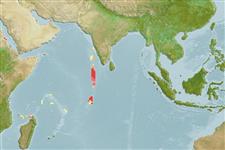Classification / Names
Nomi Comuni | Sinonimi | Catalog of Fishes(Genere, Specie) | ITIS | CoL | WoRMS | Cloffa
>
Eupercaria/misc (Various families in series Eupercaria) >
Labridae (Wrasses) > Corinae
Etymology: Coris: Greek, kore, -es = pupil and also with themenaing of "maid" (Ref. 45335); latifasciata: Name from the Latin, referring to the broad dark bars dorsally on the body (Ref. 93522).
Environment: milieu / climate zone / depth range / distribution range
Ecologia
marino associati a barriera corallina; distribuzione batimetrica 10 - 28 m (Ref. 93522). Tropical
Indian Ocean: Maldive Islands and Chagos Archipelago.
Size / Peso / Age
Maturity: Lm ? range ? - ? cm
Max length : 9.4 cm SL maschio/sesso non determinato; (Ref. 93522)
Short description
Morfologia | Morfometria
Spine dorsali (totale): 9; Raggi dorsali molli (totale): 11; Spine anali 3; Raggi anali molli: 11. This species is distinguished by the following characters: D IX,11; A III,11; pectoral rays 14 (rarely 15); lateral-line scales 50-52 (+1); scaleless head; gill rakers 19-22; a pair of large, strongly projecting, slightly recurved canine teeth anteriorly in each jaw, the upper pair slightly out-flaring, the lowers fitting between uppers when mouth closed; body depth 3.25-3.55 in SL; caudal fin truncate to slightly rounded; short pelvic fins, 1.4-1.6 in head length; body colour of adults pale blue to blue-green, the scale centers whitish, especially on abdomen, 6 dusky orange bars dorsally on body, much broader than whitish interspaces, 2 small bars on nape; broadest bar below fourth to eighth dorsal spines, curving posteriorly in its lower part; head pale green with oblique pink bands; an ocellated black spot between first and second soft rays of dorsal fin; a black spot at upper base of pectoral fin, continuing as a narrowing line across base; juveniles light blue-green with scattered small red spots, larger and more numerous on postorbital head and anterior body; a second smaller ocellus posteriorly in dorsal fin; a blackish stripe on side of snout (Ref. 93522).
Life cycle and mating behavior
Maturità | Riproduzione | Deposizione | Uova | Fecundity | Larve
Oviparous, with distinct pairing during breeding (Ref. 205).
Randall, J.E., 2013. Seven new species of labrid fishes (Coris, Iniistius, Macropharyngodon, Novaculops, and Pteragogus) from the Western Indian Ocean. J. Ocean Sci. Found. 7:1-43. (Ref. 93522)
IUCN Red List Status (Ref. 130435)
Warning: mysqli::__construct(): (HY000/1040): Too many connections in /var/www/html/includes/func_getlabel.php on line 46
Can't connect to MySQL database (fbapp). Errorcode: Too many connections
